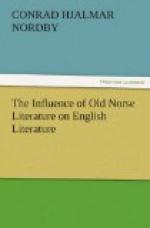One passage more from Book II:
So they climb the burg of Hindfell,
and hand in hand they fare,
Till all about and above them is nought but the
sunlit air,
And there close they cling together rejoicing
in their mirth;
For far away beneath them lie the kingdoms of
the earth,
And the garths of men-folk’s dwellings and
the streams that water them,
And the rich and plenteous acres, and the silver
ocean’s hem,
And the woodland wastes and the mountains, and
all that holdeth all;
The house and the ship and the island, the loom
and the mine and the
stall,
The beds of bane and healing, the crafts that
slay and save,
The temple of God and the Doom-ring, the cradle
and the grave.
(P. 145.)
These ten lines serve to illustrate very well one of the most remarkable powers of Morris. Just consider for a moment the number of details that are crowded into this picture, and then notice how few are the strokes required to put them there. For this rapid painting of a crowded canvas Morris is second to none among English poets. This power to put a whole landscape or a complex personality into a few lines is the direct outcome of his study of Old Norse literature. Icelandic poetry is characterized by this quality. One has but to compare the account of the end of the world as it is found in the last strophes of Voeluspa, or in the Prose Edda, with the similar account in Revelations to see how much two languages may differ in this respect. It would seem as if the short verses characteristic of Icelandic poetry forbade lengthy descriptions. The effect must be produced by a number of quick strokes: there is never time to go over a line once made. A simile is never elaborated, a new one is made when the poet wishes to insist on the figure. Take the second strophe of the “Ancient Lay of Gudrun” as an example, in the translation by Morris and Magnusson:
Such was my Sigurd
Among the Sons of Giuki
As is the green leek
O’er the low grass waxen,
Or a hart high-limbed
Over hurrying deer,
Or gleed-red gold
Over grey silver.
That is the Icelandic fashion; William Morris has caught it in the Story of Sigurd. Matthew Arnold has not seen fit to use it in his “Balder Dead,” as these lines show:
Him the blind Hoder met, as
he came up
From the sea cityward, and
knew his step;
Nor yet could Hermod see his
brother’s face,
For it grew dark; but Hermod
touched his arm.
And as a spray of honeysuckle
flowers
Brushes across a tired traveller’s
face
Who shuffles thro the deep-moistened
dust,
On a May-evening, in the darkened
lanes,
And starts him that he thinks
a ghost went by—
So Hoder brushed by Hermod’s
side.
These are noble lines, but altogether foreign to Icelandic.




